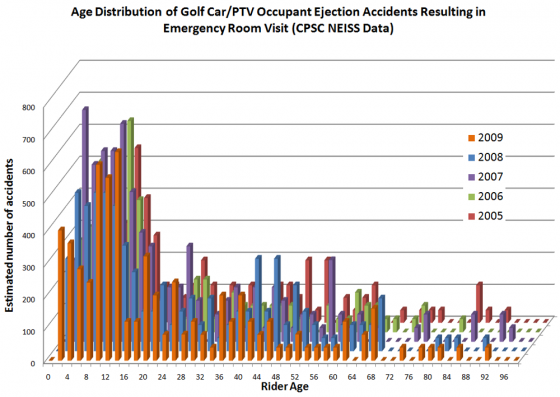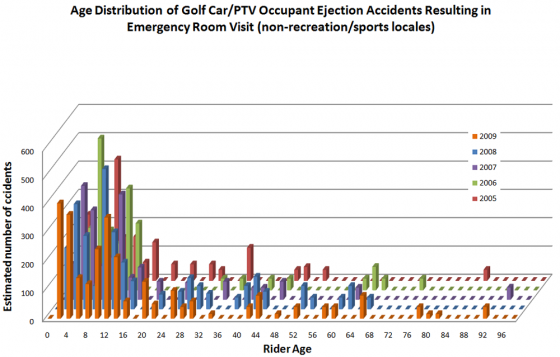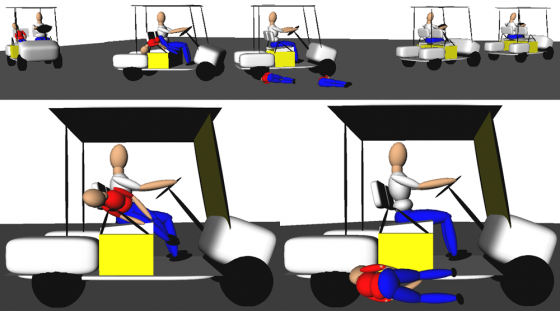According to the Consumer Products Safety Commission (CPSC), there are approximately 15,000 golf car related injuries requiring emergency room treatment in the US each year.
One significant mode of injury in golf car accidents is passenger ejection, which can lead to serious injuries, especially of the head.
Based on CPSC statistics, roughly 40% of golf car accidents involve a person falling out of the car, and many of these accidents involve young children. In addition to ejection accidents, approximately 10% of golf car accidents involve a rollover and statistics indicate that such accidents are roughly twice as likely to lead to injuries requiring a hospital stay as non-rollover accidents.
Passenger Ejections
One common scenario for a passenger ejection accident occurs when a car, traveling near its maximum speed, is turned sharply to the left. During a sharp left turn, centrifugal acceleration forces tend to force the passenger to his right, which can lead to ejection. Sharp turns are less likely to lead to a driver ejection because the driver has the steering wheel to hold onto and can always anticipate when he is about to initiate a turn.

Golf cars (when used on golf courses) are typically not equipped with seatbelts because of their need to allow passengers to enter and exit the vehicle frequently with ease. Therefore, the ANSI (American National Standards Institute) golf car safety standard, Z130.1, does not require seatbelts for golf cars. As a result, it is necessary to equip golf cars with passive restraints that will protect unbelted passengers from ejection. In place of seatbelts, golf car standards require readily accessible handholds and body restraints that prevent the occupants from sliding to the outside of the vehicle. As a result, golf cars are typically designed with rectangular or semicircular bars that rise up from each side of the car’s bench seat and are designed to serve as both handholds and hip restraints. One of the deficiencies of this design is that the location of the handhold (i.e. at the outboard edge of the seat) is also the fulcrum about which an ejected passenger will tend to rotate. Therefore, this type of handhold, even when used, does not provide the passenger sufficient leverage to prevent ejection. Another possible deficiency is that the side restraint is often not large enough to prevent ejections.
Technology Associates has performed biomechanical simulations of golf car passenger ejections using the Articulated Total Body (ATB) software to evaluate the effectiveness of existing hip restraints. This research indicates that many of the hip restraint configurations currently installed on golf cars, which can be as short as 3-4”, are not adequate to prevent passenger ejection during a sharp turn at high speed. However, restraint design improvements, such as the addition of a centrally mounted handhold, can be easily provided and would greatly reduce the likelihood of passenger ejection without interfering with convenient entry and exit from the passenger side of the seat.
Child Ejections and Seatbelts
CPSC injury statistics indicate that approximately 40% of all golf car related accidents involve children (i.e. age < 16) and 50% of these involve a fall from a moving car. As a result, children represent a dramatically large portion of all ejection accident victims.

These statistics include the class of vehicles officially categorized as Personal Transport Vehicles (PTV’s), which are golf cart style vehicles used at locations other than golf courses.

Since there are currently no occupant restrictions or seatbelt requirements for these vehicles set forth in the applicable ANSI safety standards or manufacturers’ operator’s manuals, young children of any age are often permitted to ride in open, off-road vehicles that are capable of traveling up to 20 mph on flat ground and are not equipped with seatbelts. The results of this practice are headlines like the ones listed here:
Child dies in golf cart accident: “An 8-year-old girl…died Sunday after falling from a golf cart two days earlier…” The Neshoba Democrat, September 07, 2005
Volunteer, 15, Dies Days After Golf Cart Fall: “A boy, 15, from West Covina died several days after falling off a golf cart while doing volunteer work at a Long Beach festival…” cbs2.com, Aug 5, 2007
Prayers, support strengthened family of boy hurt in fall from golf cart: “Shawn, 9, had undergone brain surgery for a severe head injury he received when he fell off the back of a golf cart in which he was riding…” The Eagle Tribune, November 14, 2007
14-Year-Old Dies After Fall From Golf Cart: “Haley was a passenger in the golf cart and fell out when it went around the corner…”, WYFF4.com, January 21, 2008
12-year-old boy dies in golf cart crash: “A 12-year-old boy… has died after being thrown from a golf cart driven by his father” Las Vegas Sun, Sep 8, 2008.
Child injured after being run over by golf cart: “Fonville fell out, and was then run over by the cart…” News-Leader.com, July 18, 2009
Teenager hurt after falling out of golf cart: “A 13-year-old girl from Columbia, Ill., suffered serious injuries Saturday after she fell out of a golf cart and hit her head on the road…” News-Leader.com, August 16, 2009
Hoover boy dies from injury in fall from golf cart: “A 15-year-old Hoover boy died Sunday from injuries he received after falling from a golf cart…” The Birmingham News, March 22, 2010
Golf Cart Head Injury Claims Bella Wiegert, 6: “the family’s red, electric cart hit a bump on Chippendale Road and Bella fell out, striking her head on the pavement…” The Ledger, Lakeland, FL, April 26, 2010
Teen boy dies after falling off golf cart: “A 14-year-old Kamuela boy died Thursday… The cart made a sharp left turn into a driveway, and Derego, who was riding in the back, fell off and struck the pavement, police said.” Honolulu Star Bulletin, June 5, 2010
Manson boy hurt in golf cart accident: “A 15-year-old Manson boy was flown to a Seattle trauma center Tuesday night after he was thrown from a golf cart and showed signs of a possible skull fracture, authorities said…. He was riding in a golf cart with a friend at the Lake Chelan Municipal Golf Course, when the friend drove down a steep hill near the 18th hole and turned left, causing Lolos to fall out of the cart…” The Wenatchee World, June 23, 2010
Anthropomorphic Hybrid III dummy testing and computer simulation analyses have confirmed that children are especially susceptible to ejection from these vehicles because of their small size, their inability to touch their feet to the floor, and their reliance upon the hip restraint for stability. The same studies have shown that seatbelts are extremely effective in preventing occupant ejection.

Child Ejection Sequence
The National Golf Car Manufacturers Association (NGCMA) has put forth the opinion that golf cars and PTVs should not have any type of seatbelt system in light of the absence of a rollover protective structure (ROPS), though the National Highway Traffic Safety Administration (NHTSA) has concluded that “the conjecture by some commenters that it would be valuable to be able to jump out of an LSV are unsubstantiated speculation that is especially unpersuasive given the volume of data showing that ejection is extremely dangerous and that seatbelts are remarkably effective at preventing ejection”.
In light of these facts, children should be prohibited from riding in golf cars without a seatbelt type restraint when driven on golf courses and seatbelt type restraints, with ROPS if necessary, should be provided for each occupant, especially children, when driving outside the golf course setting.
For related articles, see:
downtownlalaw.com article 1
downtownlalaw.com article 2